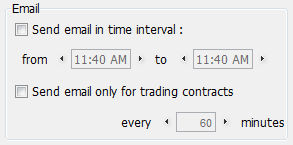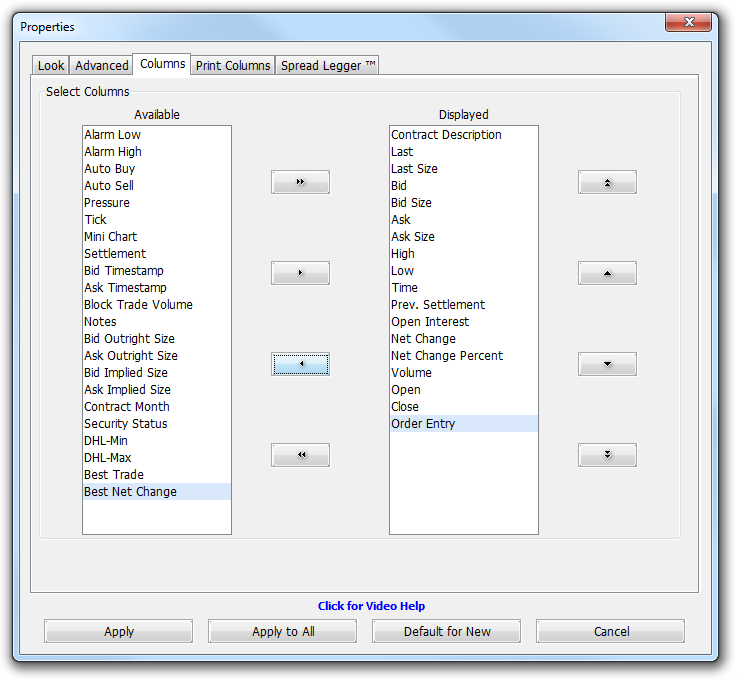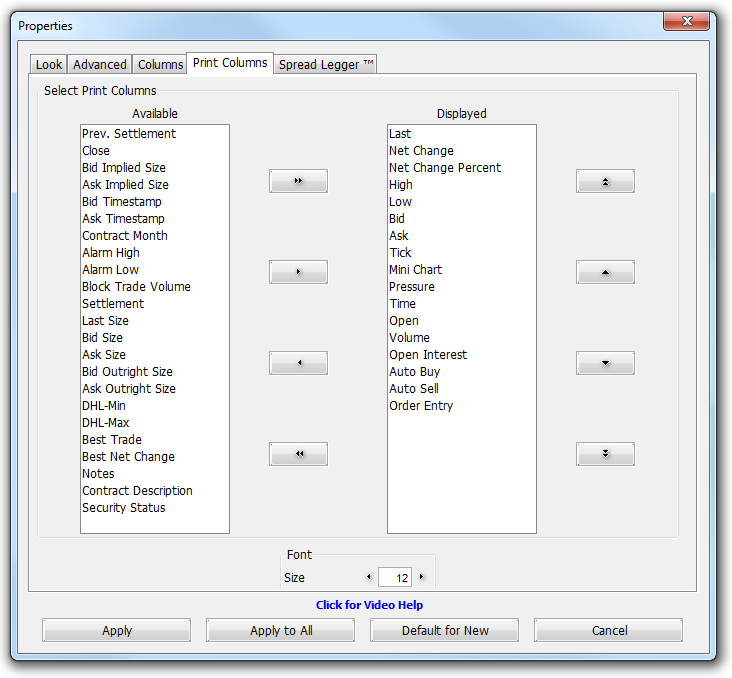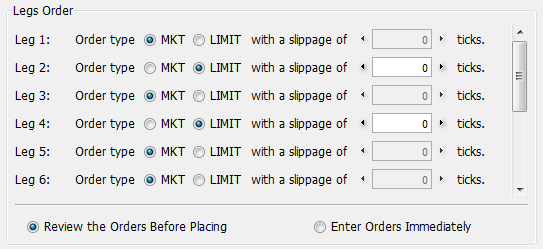 Quotes Monitor Properties
Quotes Monitor Properties
|
|
 Quotes Monitor Properties
Quotes Monitor Properties
This dialog allows you to customize the look and behavior of your currently-active Quotes Monitor frame (or all current, even future frames of this type). The options are grouped under five tabs:
|
Look Advanced Columns Print Columns Spread LeggerTM |
|
Background - the background color for odd/even rows Foreground - the text color for odd/even rows NC negative - the text color of Net Change if negative, for odd/even rows. Same color applies for the elements showing a downtrend of the market, in the Tick column. NC positive - the text color of Net Change if positive, for odd/even rows. Same color applies for the elements showing an uptrend of the market, in the Tick column. In order to change any of the colors mentioned above, press the |

|
|
Loading Quote - the color to be used while a quote is being loaded Unknown Quote - the color used for displaying an unknown quote (contract) In order to change any of the colors mentioned above, press the |

|
|
You can define the color of the Pressure bar in this section: Low to Last - the color for the lower prices Last to High - the text color for the last to high prices Open - the color of the arrow indicating the open price In order to change any of the colors mentioned above, press the |

|
|
Titles - the alignment for the titles (in title rows) Quotes - the alignment in the quote rows |

|
|
Background - the background color for title rows Foreground - the text color for title rows In order to change any of the colors mentioned above, press the You can also specify the font size and style for title rows here. You can use Bolded or normal text for these rows. |

|
|
In this section you can change the font size and style (Bold or Normal font) for the odd and even rows. |

|
|
When the information in a cell is updating, you can set the cell to be highlighted by checking the Enabled option from this section. After you enabled this option, you can select the Background and Foreground color (text color) for this highlighted cells. In order to change any of the colors mentioned above, press the |

|
|
By checking the Enabled option from this section, you can make the Last, Low and High cells to be highlighted when the information is updating. After you enabled this option, you can select the Background and Foreground color (text color) for this highlighted cells. In order to change any of the colors mentioned above, press the |

|
|
You can preview in this section the changes you made above. |

|

|
Send email in time interval allows the user to set up a timeframe throughout snapshots of his or her Quotes Monitor will be sent. As soon as the option is checked, one will notice that the every ... minutes value must also be set. Please note that the e-mail address in use will be the one associated with your account, unless an explicit one has been set (from general Application Properties -> Layout and Organization tab -> Email section). While the above option will send snapshots containing all contracts in your frame, one may want to receive updates only for the ones currently trading: Send email only for trading contracts; again, every ... minutes needs to be specified. |

|
|
Tick customizes the number of elements that will be shown in the column with the same name; the direction of the dataflow and the number of the ticks can also be specified. In order to read more about the Tick column, take a look at the Quotes Monitor Columns Help page. |

|
|
Show Tooltip concerns the display or suppression of specific extra info, when the cursor is held over a cell. For the Contract column, it will show the "long" name of the contract, while for the Order Entry column, it will display real-time account updates. |

|
|
Actions section customizes what happens when a contract is double-clicked: one may want to Edit the contract, launch a daily Chart or display an Options Chain. This applies only when the user is in One-click-trading Mode. The way the Charts or Options frame will be opened can be changed from the Triggering tab of the Application Properties dialog. |

|
|
The Timestamp can be set to Show Trading Date or, since a trading session can actually encompass more than one calendar day, to Show Calendar Date. This option will change the information in the Time column of the Quotes Monitor frame. |

|
|
The Last foreground setting dictates the color of the text in the Last column. While default color is self-explanatory (as set on the Look tab), one may also choose to have the color vary depending on the delta (difference) between the current Last value and the previous Last (LS) or Settlement (ST). These colors will depend on what NC negative and NC positive are set to, on the previous Look tab. |

|
|
Display Strategies Type will add a type suffix to every exchange-traded strategy entered in a Quotes Monitor; thus, instead of showing a "vanilla" ESM14:H15 two-legged strategy, we will get to see a formula like: ESM14:H15[EQ] (where EQ stands for Equity calendar spread). |

|
|
Represent Prices With Decimals will force even prices disseminated by the Exchange with the caret (^) symbol to be shown in a decimal format. |

|
|
Show bid/ask/trade size, when active, will place this bit of information in the respective columns (Last, Bid and Ask), after the aforementioned prices, between parentheses. Disable rows drag and drop when checked will block the implicit feature that allows one to "grab" a row (hold down the left mouse key) and then move and finally "drop" it (by releasing the mouse button) to a new desired location. The drag and drop functionality makes sense only when the user is in One-click-trading Mode. In order to read more about the Quotes Monitor drag-and-drop functionality, please click here. |

|


This window is divided by two lists: Available, on the left, shows what columns are not included in your Quotes Monitor's table view; Displayed lists the ones already present in the frame.
In order to move columns between these lists, first of all select an entry and then use the single left or single right arrow ( ,
,  ). Using the double-arrow buttons (
). Using the double-arrow buttons ( ,
,  ), all the entries will be moved accordingly.
), all the entries will be moved accordingly.
Finally, you can rearrange the place of a column in your Quotes Monitor by selecting it with your mouse (from the rightmost list) and then using the vertical arrows ( ,
,  ,
,  ,
,  ).
).
In order to read more about the columns that can be added to your Quotes Monitor frame, please click here.


The columns that will be included in your prints are controlled by here. These can be set independently from the ones in the precedent tab (Columns); however, the same adjusting techniques will be used here as well.

|
The Spread Legger allows one to decide how the system should handle placing orders on synthetic (mathematic) strategies. There are two approaches in this case: Place Strategy Order and Place Legs Order; one of them will be active at all times. Place Legs Order will place a separate order on each leg. Please note that these are independent orders. In an extreme situation, some legs may be executed, even if others fail. Place Strategy Order will follow a slightly more complicated algorithm. First of all, an attempt is made to map the arithmetic strategy to an Exchange-traded one (e.g. ZCH14 - ZCH15 would be mapped on ZCH14:H15[SP]). If this process is successful, then the resulting order will be atomic, as it is placed on a single instrument. If the attempt failed, a so-called "multileg order" (atomic as well) is sent to the Order Entry Provider. Multileg orders are not supported by all Order Entry Providers at this time; those that do not, will reject the order. Providers that support such orders will have the responsibility to map the multileg order on a strategy; if such an attempt is, again, unsuccessful, it will be rejected (a special case is that of the Options Spreads, where a new strategy may be requested at the Exchange by User Defined Strategy). |

|
|
By cutomizing the Order type and adjusting the slippage, the flexibility of this approach is increased. If you select the Review the Orders Before Placing option, the Order Preview dialog will appear before placing the orders, otherwise if you don't need to review your orders, you can select Enter Orders Immediately. |

|
|
In this section you can define the quantity that will be used for each leg when a multileg order or a strategy is placed. Selecting the Use Default Quantity From Order Entry Preferences option will use the default Order Entry quantity, which can be changed from the Order Quantity tab of the Order Entry Properties dialog or from the Order Entry Toolbar. By using the second option - Use Available Size - the application will take in consideration the available size of the cell you clicked on: Ask Size for Ask column, Bid Size for Bid column, respectively Last Size for Last column. (For example, if one were to place a buy order by left-clicking on the Ask column of a synthetic spread entered as Leg1 – Leg2 and the sell would show at that time a size of 4, the resulting order would say: "Buy 4 of Leg1 and Sell 4 of Leg2".) (As a reminder, the aforementioned cells type invoke Order Entry actions throughout the application, where present - consult the Order Entry section for details.) |

|

It is important to mention that you have 4 different buttons to select from once you finished making the necessary changes to the Quotes Monitor frame you invoked the Properties dialog on:

|
Apply - Press if you want to save the changes for the current Quotes Monitor frame only. Will close the Properties dialog.
Apply to All - Use this button if you want to apply the settings to all your existing (already open) Quotes Monitor frames, regardless of their location or visibility.
Default for New - The changes you made will be saved as default and applied to all Quotes Monitor frames you will open in the future.
Cancel - Press this button if you want to revert the changes you made in the Quotes Monitor Properties dialog.
